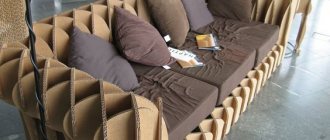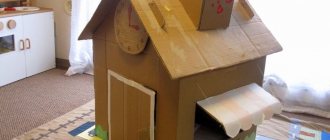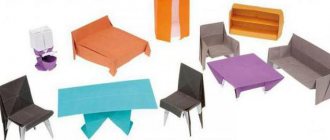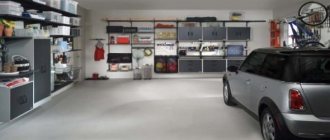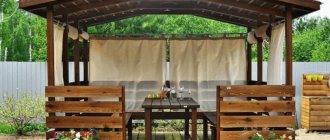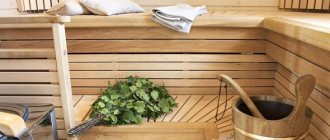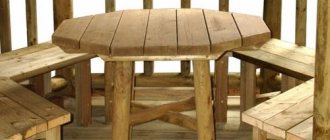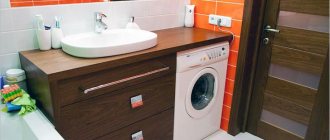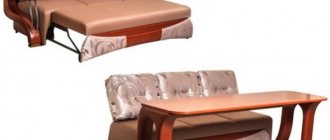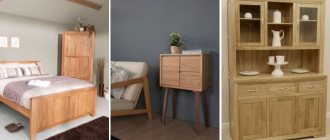Cardboard furniture is a great alternative if you can’t afford regular furniture! Tables, chairs and sofas can be made from cardboard with your own hands!
Such an ordinary thing as cardboard, which we often throw away without thinking with the rest of the garbage, can turn out to be an excellent material for building good furniture. Of course, you can assume that such interior items will be fragile and will easily bend under the weight of objects placed on it, but this can and should be avoided by properly processing the cardboard.
Advantages of cardboard furniture
Such furniture has a lot of positive advantages:
- Stylish design. You can design any thing for your home, based only on your taste or the preferences of your family;
- Economy. Spend very little money to buy the necessary tools, and you won’t have to spend money on delivery/installation;
- Mobility. With lightweight, immediately foldable furniture, moving will not be your nightmare - you will only have the joy of packing things for your new life;
- Ergonomics. There is no need to walk around an endless store in search of “that very thing” that will simultaneously appeal to you, fit into the interior and be comfortable - from now on you can combine these three qualities;
- Safety. There are absolutely no harmful or dangerous elements in cardboard furniture - after all, you make furniture from boxes with your own hands, which means you check and see all the components;
- Environmental friendliness. The furniture has lost its former appearance and attractiveness, or you decide to change the design - just take it apart and put it in a bag. You can throw it away without worrying, or you can use it to light a fire for barbecue - cardboard will not harm the environment in any way!
- Strength. If cardboard is processed correctly, furniture made from it will last a very long time.
Despite the large number of advantages, cardboard furniture has one extremely unpleasant feature - when it is in a humid environment, the furniture deteriorates and becomes unsuitable for use.
Take this fact into account and always remove cardboard furniture from the street, otherwise sudden rain may render it unusable.
Chest of drawers for needlewomen
After watching the video, you can learn about a simple way to make a small chest of drawers from four unnecessary boxes installed in one row. To connect them together, you need wide double-sided and regular tape; to strengthen the structure, pasting is done with a second layer of cardboard. Handles made from small square boxes of the same size are attached to the drawers. The product is decorated with gray tape to match the color of the working material, colored stripes are made with red insulating tape. The author recommends using a chest of drawers for storing needlework and knitting supplies.
Tools and materials for manufacturing
What is needed to make cardboard furniture with your own hands? The constant materials will be:
- Packaging cardboard/cardboard boxes – you can ask for boxes in the store or look for purchased equipment at home;
- Regular and colored tape, paper tape, double-sided tape;
- A stationery knife for cutting cardboard (watch the sharpness of the blades and change them as they become dull);
- Sharp scissors;
- Dull knife;
- Roulette/iron ruler;
- Pencil and eraser;
- Glue (PVA, hot melt glue, wallpaper glue, liquid “moment” - depending on the situation, but sometimes you can only get by with tape);
- Sandpaper (you will use it to sand the cardboard sections);
- Kraft paper (white and dark) and tracing paper.
Types of cardboard
To make cardboard furniture with your own hands, you will need different cardboard, depending on the situation.
Cardboard can be one-, two-, or three-layer, depending on the number of layers, which, in turn, consist of small waves that can be seen on the cut of the cardboard. The more layers of cardboard with waves, the thicker the cardboard. Also, do not forget to determine the sides of the cardboard before starting work:
- smooth (sometimes with drawings) side - front,
- rough - purl.
To strengthen the edges of cardboard furniture, use dark-colored kraft paper, gluing all the seams with it, using wallpaper glue. Stick white paper (or tracing paper) on all furniture - it makes decorating the furniture easier.
Remember: craft paper and tracing paper must be torn by hand before gluing, not cut!
How to beautifully design and decorate storage boxes
How to make cardboard furniture more durable
Depending on the purpose of the item (whether it be a chest for children's toys or a TV stand), cardboard is strengthened in different ways. For a more reliable and durable fastening, you must remember the following:
- To strengthen the cardboard and protect it from moisture, use parquet varnish, applying it to finished and decorated parts of the furniture;
- Try to make furniture symmetrical - it is more stable than irregularly shaped furniture;
- If you make asymmetrical furniture, then add more supports to it for strength;
- The more cross sections your furniture has, the more stable it is;
- To give more strength to your structure, use a trick - make two layers of cardboard on all furniture elements. But, pay attention, the layers must be different: one layer must have horizontal waves, the other must have vertical ones;
- Light cardboard is less durable than dark cardboard;
- The thicker the cardboard, the stronger it is.
From small items to office kits
Cardboard, as a material for furniture production, is rapidly becoming fashionable. Entire trends in such furniture art are being created, each of the companies operating in this market works in its own style.
It’s easy to order almost everything, from an original lamp for a desk, to the table itself, and even to bulky furniture for books, documents and clothes.
It should not be surprising that cardboard is able to withstand mechanical loads. Paper, as everyone knows, is made from cellulose, which, in turn, forms the basis of wood.
And everyone knows the strength of wood and the widest possibilities for its use. Therefore, to ensure the strength of cardboard products, it is enough to assemble them properly. Moreover, there is a lot of cardboard on the market specifically designed for these purposes, as well as different types of glue, paint and other finishing materials.
How to use cardboard furniture
How to properly use hand-made cardboard furniture
In order for your cardboard new thing to serve faithfully for a long time, do not forget that:
- Cardboard furniture is afraid of moisture (varnish will not save you from rain);
- Use it for its intended purpose: if you have made a table for letters/keys/changes, do not place a bulky flower pot on it;
- Make sure that there is no open fire near cardboard furniture (be it a fireplace, a fire, or even a cigarette) - you may lose not only a piece of furniture if you allow a fire hazard.
How to make furniture from cardboard with your own hands if only a box comes to mind? What can you make from a shoe box? We are in a hurry to surprise you - you can make a lot of amazing things from cardboard that harmoniously fit into the interior, from the nursery to the hallway, and if you are completely overwhelmed by inspiration, then there are many ideas for the office and country house.
Below you will see how to make cardboard furniture with your own hands using patterns and diagrams. For the first time, choose something that is not too complicated to get comfortable with the manufacturing technique.
Important! When designing furniture, remember that 0.6 cm will take up furniture decoration, and always add these centimeters when measuring dimensions.
More tips
It is important to know that crafts made from juice boxes are suitable not only for making feeders. You can also make houses for little dolls from them.
All you need to do is carefully cover the future house with beautiful paper, cut out the windows and door. Glue the curtains to the windows from the inside and voila! The house is ready! Now the child becomes the happy owner of a unique craft.
But a house without furniture is not a completed job. Therefore, we take more matchboxes and make furniture out of them for the newly built house.
- Angorka. What it is?
- Flowers as gifts.
- Dream Island - a place for a family holiday
There are many types of matchbox crafts. You can use them to make an imitation of a brick wall, or even lay out a toy fireplace for a dollhouse. Or you can glue the boxes together to form three-dimensional letters, and put the letters into words.
And there is an option with cute forest animals, where matchboxes are painted in the color of the animal. Next, we glue the corresponding ears (on top) and tail (back down) to it. Draw the eyes, nose and mouth. Antennae can be made from wire.
You need to glue the paws to the very bottom of the box. With such animals you can organize a whole children's fairy-tale performance.
It all depends on your imagination. The main thing is to have a good attitude and patience. Then all your crafts will be done with soul.
Master class No. 1: Cardboard shoe stand
We decided to simplify your task - we put the first master class that anyone can assemble. So, armed with all the necessary items, let's get started.
Step 1
- Take sheets of cardboard - approximately 21x24cm - and divide them into three equal strips; Using a dull knife, press the strips thoroughly so that they bend.
- Cover the long sides of the sheet with any colored tape.
- Then fold the sheets into triangular oblong shapes and secure with the same tape.
Step 2
You can make any number of triangles. To secure the shelves, take whole sheets of cardboard and glue the triangles to them with double-sided tape or PVA. You can put a sheet of cardboard on the very top and put high boots on it.
Chair decor with fabric
Decorating with fabric is convenient when you need to frequently change the appearance of furniture.
A simple way is to decorate the back of a chair using a piece of fabric.
- The fabric can be tied to the back and secured with a bow.
- Flowing fabrics are suitable for this method: acrylic, lycra, chiffon, crepe-satin, light cotton.
- From flowing fabric you can sew a universal fabric measuring 1.3m x 1.3m or 1.5m x 1.5m, which is suitable for a chair of any shape and size.
- The canvas is draped over the chair and secured with pins on the back.
- The fabric is also used to make covers according to the size of the chair.
- To do this, first take measurements with seam allowances, make a pattern on paper and transfer it to the fabric. Thick, wear-resistant fabrics are suitable for sewing covers.
- Taking measurements can be simplified if you use a rough piece of fabric rather than paper for marking.
- To do this, you need to attach pieces of fabric to the seat and back with pins or double-sided tape, and then draw with a marker all the lines that will be sewn together.
- Next, trim off any excess fabric at the seam allowance. From such a fabric pattern you can sew a rough version of the cover.
Another way to use fabric to decorate a chair is to update the upholstery of a soft seat.
Master class No. 2: Cardboard bookshelf
Step 1
Take long, not wide sheets of cardboard - some of the sheets will be used for vertical bases, so they should be a little longer; in general, the size of the sheets can be any size at your discretion. You can look for such sheets in hardware stores - sometimes they throw them away with just such cuts.
If you can’t find it, take solid (without bends!) sheets and measure for the cutting line so that on all sheets they coincide when threaded into each other.
Step 2
If you take thick cardboard sheets, then when you connect them together they will hold tightly and without additional means. Thin sheets can be secured together with hot glue; it will dry quickly, so you will have to act quickly when joining the sheets. After joining the sheets, you can already use the shelf.
Where to start?
You should start with organizing your workplace. You will need normal lighting, several square meters on the floor (maybe a separate table), shelves for tools and accessories.
New life for your balcony: non-standard ideas for renovation- Discounts on windows - how to distinguish a fake from the generosity of a window company?
- How to choose blinds?
As for projects, you should start with simple things in order to gain experience and get a feel for the material. Then, after the technique has been perfected, you can begin complex projects.
Master class No. 3: Hanging shoe rack
- Take a couple of large sheets of cardboard and mark them into equal rectangles based on the size of your shoes. Then cut them out.
- Fold each rectangle as shown in the photo, and secure the resulting pockets with tape.
- Insert the pockets into each other so that it is easy to secure them with double-sided tape, but still leaves room for shoes.
- You can fix the shelf on the door - it will not interfere with you at all and take up a lot of space.
Types of shoe racks
Shoe racks are usually divided into several types.
A shoe cabinet with a seat is becoming increasingly popular. It may be sold separately or as part of a headset. A distinctive feature of this model is a comfortable soft seat located on top or on the side, which allows you to avoid the use of additional benches and banquettes in the hallway. Such a cabinet will certainly become a bright detail in your corridor.
A shoe rack with a hanger would be an excellent option for a small hallway. You can store not only shoes in it, but also jackets, raincoats, and coats. This model looks especially stylish in white.
Another solution for a small hallway is a narrow cabinet. It’s unlikely to fit all the shoes, but seasonal shoes certainly will.
A wall-mounted shoe rack with folding shelves will look interesting. Usually it is small in size (width does not exceed 25 cm). This model is attached to the wall, which makes it stationary.
We recommend looking at a detailed review of shoe cabinets for the hallway on our partners’ website: https://mblx.ru/tumbochka/218-tumba-dlya-obuvi-v-prihozhuyu.html many photos of modern cabinets, as well as recommendations from the pros!
An original option for the hallway is a cabinet with a mirror. It can be bought at any furniture store.
All the types described above are classified as closed cabinets. They hide shoes, which are not always beautiful, from prying eyes. The disadvantage is the lack of ventilation, which leads to an unpleasant odor. Drying products equipped with an ultraviolet lamp do not have this disadvantage. Shoes in them are disinfected as they dry.
Open cabinets look like a rack with shelves. This design solution has its pros and cons.
The advantages include:
- constant airing of shoes;
- no need to wash shoes after every walk;
- You don't have to open the doors to get your shoes out.
Master class No. 4: DIY laptop stand
Almost each of us has an indispensable tool for work and communication - a laptop. And we have to buy all sorts of peripheral devices for it (mouse, flash drives, removable hard drives, etc.). And so, when there is a desire to put it on a stand for ease of use, we are forced to go to the store and spend extra money. For those who want to avoid unnecessary expenses, but do not want to give up the stand, there is an excellent solution - to make it yourself. And how to do this - you will read in this article.
Materials and tools:
- Laptop to measure stand size;
- yardstick;
- several sheets of paper or newspaper for a stencil;
- thick cardboard for the stand itself (you can use an unnecessary box);
- long ruler;
- marker or pencil;
- large scissors or a utility knife.
You already understand that we don’t need any special materials - everything listed is probably available in any home. Let's start production.
Step 1.
Take paper or newspaper and spread it on a flat surface. It is better to carry out all actions related to measuring the size of the stand and making a stencil according to the “measure seven times, cut once” principle, because at best the stand will be crooked, and at worst it will not hold the laptop.
- First we will make a leg (this is a crossbar between the legs to give the stand more rigidity). We take a tape measure and measure the length of the laptop along the keyboard, from corner to corner.
- Mark exactly half of this length with a marker on paper.
- We draw a line - this will be half of the base of the pole. It's better not to draw this detail entirely. Make a slight inaccuracy and the laptop will stand crooked.
- We measure up from the edges of the segment 4 cm and 7 cm. Draw a rectangle.
- Mentally divide the rectangle into 3 parts: the first third is an almost straight line at a height of 4 cm, the second third is with a pattern or hand making a bend at an angle of 45 degrees to the 7 cm line, the last third is from the right end of the segment we draw a line to the 7 cm line at an angle 45 degrees.
- All this is simply and clearly shown in the photo (detail 1). At the point where the two curved lines meet, a narrow sleeve is made - at this place there will be a cutout for aligning the parts.
Step 2.
The same photo shows a template for the legs of the stand (detail 2).
You select the angle of the stand based on your personal preferences. This will add up to the height of the right and left sides of the leg. When drawing the template for the leg, pay attention to the tooth that will subsequently keep the laptop from falling.
In height, it should be at least a third of the thickness of the laptop. The slot in the leg for coupling with the leg should not be in the middle, but at a distance of approximately 1/3 from the far edge. This also affects the stability of the structure. Curves are at your discretion.
The slots in the legs and leg can be no more than 3-4 cm in height. They can be 3-5 mm in width depending on the thickness of the cardboard, but in both parts they can be the same.
Step 3.
Cut out paper templates. We attach the template of 1 part with the bottom cut to the even edge of the box chosen as the future stand. It is desirable that the stable parts of the stand are perfectly level (the stand will not wobble on the table).
- Carefully trace the template on one side, then flip it over to the other side and continue tracing. We get one continuous symmetrical part (leg). Apply parts only to smooth parts of the box (pieces of cardboard) where there are no folds.
- On another cardboard (for example, the bottom of a box) we place the paper template of part 2, i.e. leg. We circle and repeat the same a second time. The legs must be absolutely identical.
Step 4.
We cut out all the details with scissors or a stationery knife. We move them along the slots, as shown in the photo.
If everything is combined correctly, then you can be glad that a simple (like all ingenious), functional, strong stand for your digital friend is ready! Install a laptop on it and attach additional keyboards to it, watch movies at a comfortable height, sweep cookie crumbs under the stand - you are now the happy owner of a homemade laptop stand!
Origami sofa
It's hard to imagine a living room without a sofa. For a guest, this is a great place to sit down, and for the owner, it’s a great place to lie down and relax after work. Let's make a sofa out of paper using the origami technique, as in the photo: Diagram:
Step-by-step instruction:
- Fold the sheet in half (twice) and unfold it. Get a cross-shaped fold.
- Fold 1/6 of the page along the dotted line (see photo).
- We wrap the sheet along the fold opposite this strip.
- We wrap the side parts of the resulting rectangle, 1/3 on each side.
- Bend the corners forward (in the places indicated by the white arrow). We do not touch the back side of the sheet.
- Fold the opened white rectangles in half.
- Raise the part of the craft marked with a dotted line.
- Bend half of the raised part down.
- Bend the sides forward.
- Pull the front part (back) forward.
- We get a paper sofa.
Rules of care
The service life of cardboard furniture is unlikely to be extended with proper and timely care. It will last as long as possible without losing its original appearance if you adhere to the following recommendations:
- You cannot leave cardboard items in a damp room or on outdoor areas without a canopy;
- Cardboard catches fire quickly, so tables, chairs and sofas should be at a safe distance from gas stoves in the kitchen, fireplaces, fires;
- The fragile material is susceptible to even the slightest mechanical damage. Such furniture must be handled with care and precision.
